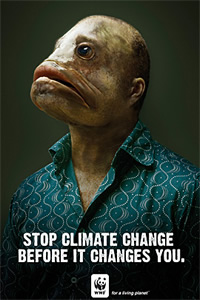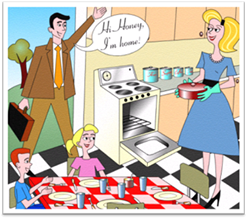Advertisements
Advertisements
Exploring imagesPhotographs and images created for commercial purposes aim to attract attention, develop interest and persuade the audience. Print advertisements are ideal for exploring familiar visual texts as they develop understanding of the language of visual elements, the aesthetics of visual texts, and the constructed nature of these texts as social products. Advertisers create images for a product to target a particular audience then use the image as the main idea or feeling they want to associate with the product. The photograph, illustration or graphic must catch or arouse the interest of the audience. Many advertisements use juxtaposition to create interest and desire in the audience. Advertisers often place the product next to visual objects to create a desire in the viewer. In the digitally manipulated image on the right, the juxtaposition of a man with the face of a fish exaggerates the effect of climate change to evoke an emotional reaction from its audience. |
Representation
|
Stereotypes |
|
|
Many visual texts use representation to portray people, places or events. Composers use a range of conventions and choose visual texts to represent groups, ideas and popular objects to make connections with the audience. Representations can range from a colour or icon to depict branding and product image to sophisticated layering of ideas about cultural and political issues. |
‘Hi Honey, I'm home!’: A stereotypical family |
Stereotyping is a representation based on the typical or commonly held idea of the subject. Stereotyping can be a way for the audience to identify familiar subjects and ideas. Advertisers will use familiar visual images and product images in sophisticated campaigns involving TV, online and social media to build brand recognition. |
Advertisement tasks
|
|
Select a colour advertisement from a print or online source and use the Guide to responding to visual texts to analyse and annotate the visual text. In your response use the appropriate terminology for evaluating the text(s). |
|
|
Create your own colour advertisement for use in print or online.
|
|
|
|
Resources
-
mUmBRELLA is an Australian media website that features some of the best Australian print ads.
-
The Best Ads website has award winning advertisements from Australia in a number of categories. Download and annotate examples from the website.
-
adFlip has print advertisements to download from a range of categories.


